Identification of Diagenetic Facies Logging of Tight Oil Reservoirs Based on Deep Learning—A Case Study in the Permian Lucaogou Formation of the Jimsar Sag, Junggar Basin
Abstract
:1. Introduction
2. Regional Geological Setting
3. Materials and Methods
3.1. Core Test and Geophysical Logging Database
3.1.1. XRD
3.1.2. Thin Sections
3.1.3. SEM
3.1.4. Logging Curve Preprocessing
3.2. Convolutional Neural Network (CNN)
3.3. Use of Method Flows during Model Building
4. Results
4.1. Basic Characteristics of the Reservoir
4.1.1. Petrological Features
4.1.2. Reservoir Physical Property Characteristics
4.1.3. The Types of Storage Space
- (1)
- Secondary dissolution pores
- (2)
- Intergranular pores
- (3)
- Microcracks
- (4)
- Primary pores
4.2. Diagenetic Facies Classification
5. Discussion
5.1. Different Diagenetic Facies Types and Their Logging Response Characteristics
5.1.1. Dissolution Facies
5.1.2. Carbonate-Cemented Facies
5.1.3. Tightly Compacted Facies
5.1.4. Quartz-Cemented Facies
5.1.5. Clay Mineral-Filling Facies
5.2. Impact of Diagenetic Facies on Reservoir Quality of Tight Oil
5.3. Prediction of Diagenetic Facies and Favorable Reservoirs
6. Conclusions
Author Contributions
Funding
Acknowledgments
Conflicts of Interest
References
- Hu, S.-Y.; Zhu, R.-K.; Wu, S.-T.; Bai, B.; Yang, Z.; Cui, J.-W. Profitable exploration and development of continental tight oil in China. Pet. Explor. Dev. 2018, 45, 737–748. [Google Scholar] [CrossRef]
- Milliken, K.L.; Curtis, M.E. Imaging pores in sedimentary rocks: Foundation of porosity prediction. Mar. Pet. Geol. 2016, 73, 590–608. [Google Scholar] [CrossRef] [Green Version]
- Wang, M.; Lu, S.; Huang, W.; Liu, W. Pore characteristics of lacustrine mudstones from the Cretaceous Qingshankou Formation, Songliao Basin. Interpretation 2017, 5, T373–T386. [Google Scholar] [CrossRef]
- Wang, J.-L.; Feng, L.-Y.; Steve, M.; Tang, X.; Gail, T.E.; Mikael, H. China’s unconventional oil: A review of its resources and outlook for long-term production. Energy 2015, 82, 31–42. [Google Scholar] [CrossRef]
- Zou, C.-N.; Zhang, G.-S.; Yang, Z.; Tao, S.-Z.; Hou, L.-H.; Zhu, R.-K.; Yuan, X.-J.; Ran, Q.-Q.; Li, D.-H.; Wang, Z.-P. Geological concepts, characteristics, resource potential and key techniques of unconventional hydrocarbon: On unconventional petroleum geology. Pet. Explor. Dev. 2013, 40, 385–399. [Google Scholar] [CrossRef]
- Sonnenberg, S.A.; Pramudito, A. Petroleum geology of the giant Elm Coulee field, Williston Basin. AAPG Bull. 2009, 93, 1127–1153. [Google Scholar] [CrossRef]
- Sun, L.; Tuo, J.; Zhang, M.; Wu, C.; Chai, S. Pore structures and fractal characteristics of nano-pores in shale of Lucaogou formation from Junggar Basin during water pressure-controlled artificial pyrolysis. J. Anal. Appl. Pyrolysis 2019, 140, 404–412. [Google Scholar] [CrossRef]
- Clarkson, C.R.; Wood, J.M.; Burgis, S.E.; Aquino, S.D.; Freeman, M. Nanopore-Structure Analysis and Permeability Predictions for a Tight Gas Siltstone Reservoir by Use of Low-Pressure Adsorption and Mercury-Intrusion Techniques. SPE Reserv. Eval. Eng. 2012, 15, 648–661. [Google Scholar] [CrossRef]
- Pollastro, R.-H. Total petroleum system assessment of undiscovered resources in the giant Barnett Shale continuous (uncon-ventional) gas accumulation, Fort Worth Basin, Texas. AAPG Bull. 2007, 91, 551–578. [Google Scholar] [CrossRef]
- Zha, M.; Wang, S.; Ding, X.; Feng, Q.; Xue, H.; Su, Y. Tight oil accumulation mechanisms of the Lucaogou Formation in the Jimsar Sag, NW China: Insights from pore network modeling and physical experiments. J. Southeast Asian Earth Sci. 2018, 178, 204–215. [Google Scholar] [CrossRef]
- Yang, Y.; Qiu, L.; Wan, M.; Jia, X.; Cao, Y.; Lei, D.; Qu, C. Depositional model for a salinized lacustrine basin: The Permian Lucaogou Formation, Jimsar Sag, Junggar Basin, NW China. J. Southeast Asian Earth Sci. 2018, 178, 81–95. [Google Scholar] [CrossRef]
- Du, J.-H.; Hu, S.-Y.; Pang, Z.-L.; Lin, S.-H.; Hou, L.-H.; Zhu, R.-K. The types, potentials and prospects of continental shale oil in China. China Pet. Explor. 2019, 24, 560–568. [Google Scholar]
- Pang, H.; Pang, X.-Q.; Dong, L.; Zhao, X. Factors impacting on oil retention in lacustrine shale: Permian Lucaogou Formation in Jimusaer Depression, Junggar Basin. J. Pet. Sci. Eng. 2018, 163, 79–90. [Google Scholar] [CrossRef]
- Su, Y.; Zha, M.; Ding, X.; Qu, J.; Gao, C.; Jin, J.; Iglauer, S. Petrographic, palynologic and geochemical characteristics of source rocks of the Permian Lucaogou formation in Jimsar Sag, Junggar Basin, NW China: Origin of organic matter input and depositional environments. J. Pet. Sci. Eng. 2019, 183, 106364. [Google Scholar] [CrossRef]
- Lin, M.; Xi, K.; Cao, Y.; Liu, Q.; Zhang, Z.; Li, K. Petrographic features and diagenetic alteration in the shale strata of the Permian Lucaogou Formation, Jimusar sag, Junggar Basin. J. Pet. Sci. Eng. 2021, 203, 108684. [Google Scholar] [CrossRef]
- Pan, Y.; Huang, Z.; Guo, X.; Li, T.; Zhao, J.; Li, Z.; Qu, T.; Wang, B.; Fan, T.; Xu, X. Lithofacies types, reservoir characteristics, and hydrocarbon potential of the lacustrine organic-rich fine-grained rocks affected by tephra of the permian Lucaogou formation, Santanghu basin, western China. J. Pet. Sci. Eng. 2021, 208, 109631. [Google Scholar] [CrossRef]
- Cao, Y.-C.; Zhu, N.; Zhang, S.-M.; Xi, K.-L.; Xue, X.-J. Diagenesis and Reserving Space Characteristics of Tight Oil Reservoirs of Permian Lucaogou Formation in Jimusar Sag of Junggar Basin, China. J. Earth Sci. Environ. 2019, 41, 253–266. [Google Scholar]
- Cui, Y.-F.; Wang, G.-W.; Jones, S.J.; Zhou, Z.; Ran, Y.; Lai, J.; Li, R.; Deng, L. Prediction of diagenetic facies using well logs—A case study from the upper Triassic Yanchang Formation, Ordos Basin, China. Mar. Pet. Geol. 2017, 81, 50–65. [Google Scholar] [CrossRef] [Green Version]
- Bjørlykke, K. Relationships between depositional environments, burial history and rock properties. Some principal aspects of diagenetic process in sedimentary basins. Sediment. Geol. 2014, 301, 1–14. [Google Scholar] [CrossRef]
- Ran, Z.; Wang, G.-W.; Lai, J.; Zhou, Z.-L.; Cui, Y.-F.; Dai, Q.-Q.; Chen, J.; Wang, S.-C. Quantitative Characterization of Dia-genetic Facies of Tight Sandstone Oil Reservoir by Using Logging Crossplot: A case study on Chang 7 tight sandstone oil res-ervoir in Huachi area, Ordos Basin. Acta Sedimentol. Sin. 2016, 34, 694–706. [Google Scholar]
- Karim, A.; Pe-Piper, G.; Piper, D. Controls on diagenesis of Lower Cretaceous reservoir sandstones in the western Sable Sub-basin, offshore Nova Scotia. Sediment. Geol. 2009, 224, 65–83. [Google Scholar] [CrossRef]
- Munawar, M.-J.; Lin, C.-Y.; Cnudde, V.; Bultreys, T.; Dong, C.-M.; Zhang, X.-G.; De, B.-W.; Zahid, M.-A.; Wu, Y.-Q. Petro-graphic characterization to build an accurate rock model using micro-CT: Case study on low-permeable to tight turbidite sandstone from Eocene Shahejie Formation. Micron 2017, 109, 22–33. [Google Scholar] [CrossRef] [PubMed]
- Okunuwadje, S.E.; Bowden, S.A.; Macdonald, D.I. Diagenesis and reservoir quality in high-resolution sandstone sequences: An example from the Middle Jurassic Ravenscar sandstones, Yorkshire CoastUK. Mar. Pet. Geol. 2020, 118, 104426. [Google Scholar] [CrossRef]
- Lai, J.; Fan, X.-C.; Pang, X.-J.; Zhang, X.-S.; Xiao, C.-W.; Zhao, X.-J.; Han, C.; Wang, G.-W.; Qin, Z.-Q. Correlating diagenetic facies with well logs (conventional and image) in sandstones: The Eocene Suweiyi Formation in Dina 2 Gasfield, Kuqa de-pression of China. J. Pet. Sci. Eng. 2018, 174, 617–636. [Google Scholar] [CrossRef]
- Wang, J.; Cao, Y.; Liu, K.; Liu, J.; Kashif, M. Identification of sedimentary-diagenetic facies and reservoir porosity and permeability prediction: An example from the Eocene beach-bar sandstone in the Dongying Depression, China. Mar. Pet. Geol. 2017, 82, 69–84. [Google Scholar] [CrossRef]
- Li, Y.; Chang, X.; Yin, W.; Sun, T.; Song, T. Quantitative impact of diagenesis on reservoir quality of the Triassic Chang 6 tight oil sandstones, Zhenjing area, Ordos Basin, China. Mar. Pet. Geol. 2017, 86, 1014–1028. [Google Scholar] [CrossRef]
- Shi, Y.-J.; Xiao, L.; Mao, Z.-Q.; Guo, H.-P. An identification method for diagenetic facies with well logs and its geological sig-nificance in low-permeability sandstones:A case study on Chang 8 reservoirs in the Jiyuan region, Ordos Basin. Acta Pet. Sin. 2011, 32, 820–828. [Google Scholar]
- Zhang, X.-X.; Zou, C.-N.; Tao, S.-Z.; Xu, C.-C.; Song, J.-R.; Li, G.-H. Diagenetic Facies Types and Semiquantitative Evaluation of Low Porosity and Permeability Sandstones of the Fourth Member Xujiahe Formation Guangan Area, Sichuan Basin. Acta Sedimentol. Sin. 2010, 28, 50–57. [Google Scholar]
- Lai, J.; Wang, G.-W.; Wang, S.-N.; Xin, Y.; Wu, Q.-K.; Zheng, Y.-Q.; Li, J.-D.; Cang, D. Overview and research progress in logging recognition method of clastic reservoir diagenetic facies. J. Cent. South Univ. (Sci. Technol.) 2013, 44, 4942–4953. [Google Scholar]
- Lai, J.; Wang, G.; Wang, S.; Cao, J.; Li, M.; Pang, X.; Zhou, Z.; Fan, X.; Dai, Q.; Yang, L.; et al. Review of diagenetic facies in tight sandstones: Diagenesis, diagenetic minerals, and prediction via well logs. Earth-Sci. Rev. 2018, 185, 234–258. [Google Scholar] [CrossRef]
- Ozkan, A.; Cumella, S.P.; Milliken, K.L.; Laubach, S.E. Prediction of lithofacies and reservoir quality using well logs, Late Cretaceous Williams Fork Formation, Mamm Creek field, Piceance Basin, Colorado. AAPG Bull. 2011, 95, 1699–1723. [Google Scholar] [CrossRef]
- Wang, C.-W.; Ma, D.-X.; Tian, B.; Liang, J.-S.; Wang, Q.; Liu, T.-S. Diagenetic Evolution and Facies of Shanxi Formation in LX Area of Ordos Basin. Acta Sedimentol. Sin. 2016, 34, 594–605. [Google Scholar]
- Zhu, P.; Lin, C.-Y.; Wu, P.; Fan, R.-F.; Wang, D.-R.; Liu, X.-L. Logging quantitative identification of diagenetic facies by using principal component analysis: A case of Es3x1 in Zhuang 62-66 Area, Wu Hao-zhuang Oil field. Prog. Geophys. 2015, 30, 2360–2365. [Google Scholar]
- Hinton, G.E.; Osindero, S.; Teh, Y.W. A fast learning algorithm for deep belief nets. Neural Comput. 2006, 18, 1527–1554. [Google Scholar] [CrossRef]
- Sungil, K.; Kyungbook, L.; Minhui, L.; Taewoong, A.; Jaehyoung, L.; Hwasoo, S.; Ning, F.-L. Saturation Modeling of Gas Hydrate Using Machine Learning with X-Ray CT Images. Energies 2020, 13, 5032. [Google Scholar]
- Wang, P.; Cao, Y.; Shen, C.; Liu, L.; Shen, H.T. Temporal Pyramid Pooling-Based Convolutional Neural Network for Action Recognition. IEEE Trans. Circuits Syst. Video Technol. 2016, 27, 2613–2622. [Google Scholar] [CrossRef]
- Shan, L.-Q.; Liu, Y.-C.; Tang, M.; Yang, M.; Bai, X.-Y. NN-BiLSTM hybrid neural networks with attention mechanism for well log prediction. J. Pet. Sci. Eng. 2021, 205, 108838. [Google Scholar] [CrossRef]
- Wu, H.; Li, Z.; Liu, N.; Zhang, B. Improved seismic well tie by integrating variable-size window resampling with well-tie net. J. Pet. Sci. Eng. 2021, 208, 109368. [Google Scholar] [CrossRef]
- Zhang, Y.; Zhang, C.; Ma, Q.; Zhang, X.; Zhou, H. Automatic prediction of shear wave velocity using convolutional neural networks for different reservoirs in Ordos Basin. J. Pet. Sci. Eng. 2021, 208, 109252. [Google Scholar] [CrossRef]
- Zhang, Z.-H.; Tian, J.-J.; Han, C.-C.; Zhang, W.-W.; Deng, S.-W.; Sun, G.-X. Reservoir characteristics and main controlling factors of Lucaogou Formation in Jimsar Sag, Jungger Basin. Lithol. Reserv. 2021, 33, 116–126. [Google Scholar]
- Shao, Y.; Yang, Y.-Q.; Wan, M.; Qiu, W.-L.; Cao, Y.-C.; Yang, S.-C. Sedimentary Characteristic and Facies Evolution of Permian Lucaogou Formation in Jimsar Sag, Junggar Basin. Xinjiang Pet. Geol. 2015, 36, 635–641. [Google Scholar]
- Qiu, Z.; Zou, C.; Dong, D.; Lu, B.; Shi, Z.; Tao, H.; Zhou, J.; Lei, D.; Zhang, C. Petroleum system assessment of conventional-unconventional oil in the Jimusar sag, Junggar basin, Northwest China. J. Unconv. Oil Gas Resour. 2016, 16, 53–61. [Google Scholar] [CrossRef]
- Ma, K.; Hou, J.-G.; Liu, Y.-M.; Shi, Y.-Q.; Yan, L.; Chen, F.-L. The sedimentary model of saline lacustrine mixed sedimentation in Permian Lucaogou Formation, Jimsar sag. Acta Pet. Sin. 2017, 38, 636–648. [Google Scholar]
- Wang, Y.; Teng, Q.; He, X.; Feng, J.; Zhang, T. CT-image of rock samples super resolution using 3D convolutional neural network. Comput. Geosci. 2019, 133, 104314. [Google Scholar] [CrossRef] [Green Version]
- Lima, R.-P.-D.; Duarte, D.; Nicholson, C.; Slatt, R.; Marfurt, K.-J. Petrographic microfacies classification with deep convolu-tional neural networks. Comput. Geosci. 2020, 142, 104481. [Google Scholar] [CrossRef]
- Cunha, A.; Pochet, A.; Lopes, H.; Gattass, M. Seismic fault detection in real data using transfer learning from a convolutional neural network pre-trained with synthetic seismic data. Comput. Geosci. 2019, 135, 104344. [Google Scholar] [CrossRef]
- Zha, M.; Su, Y.; Gao, C.-H.; Qu, J.-X.; Wang, X.-L.; Ding, J.-X. Tight reservoir space characteristics and controlling factors: An example from Permian Lucaogou formation in Jimsar sag, Junggar basin, northwest China. J. China Univ. Min. Technol. 2017, 46, 85–95. [Google Scholar]
- Lai, J.; Wang, G.-W.; Wang, S.-N.; Zheng, Y.-Q.; Wu, H.; Zhang, Y.-C. Research Status and Advances in the Diagenetic Facies of Clastic Reservoirs. Adv. Earth Sci. 2013, 28, 39–50. [Google Scholar]
- Li, P.; Liu, Z.-D.; Chen, Y.-M.; Zhao, J.-H. Summarization of application for identifying diagenetic facies in low porosity and low permeability reservoirs using well-logging information. Prog. Geophys. 2017, 32, 183–190. [Google Scholar]
- Lai, J.; Wang, G.; Chai, Y.; Ran, Y. Prediction of Diagenetic Facies using Well Logs: Evidences from Upper Triassic Yanchang Formation Chang 8 Sandstones in Jiyuan Region, Ordos Basin, China. Oil Gas Sci. Technol.—Rev. D’ifp Energ. Nouv. 2015, 71, 34. [Google Scholar] [CrossRef] [Green Version]
- Dutton, S.-P.; Loucks, R.-D. Diagenetic controls on evolution of porosity and permeability in lower Tertiary Wilcox sandstones from shallow to ultradeep (200–6700 m) burial, Gulf of Mexico Basin, U.S.A. Mar. Pet. Geol. 2010, 27, 69–81. [Google Scholar] [CrossRef]
- Wu, D.; Liu, X.; Du, Y.; Jiang, L.; Cheng, Z. Predictive distribution of high-quality tight reservoirs of coarse clastic rocks by linking diagenesis to sedimentary facies: Evidence from the upper Sha 4 Member in the northern Bonan Sag, Bohai Bay Basin, eastern China. Interpretation 2018, 6, T413–T429. [Google Scholar] [CrossRef]
- Higgs, K.; Crouch, E.; Raine, J. An interdisciplinary approach to reservoir characterisation; an example from the early to middle Eocene Kaimiro Formation, Taranaki Basin, New Zealand. Mar. Pet. Geol. 2017, 86, 111–139. [Google Scholar] [CrossRef]
- Henares, S.; Caracciolo, L.; Cultrone, G.; Fernández, J.; Viseras, C. The role of diagenesis and depositional facies on pore system evolution in a Triassic outcrop analogue (SE Spain). Mar. Pet. Geol. 2014, 51, 136–151. [Google Scholar] [CrossRef]
- Luo, L.; Meng, W.; Gluyas, J.; Tan, X.; Gao, X.; Feng, M.; Kong, X.; Shao, H. Diagenetic characteristics, evolution, controlling factors of diagenetic system and their impacts on reservoir quality in tight deltaic sandstones: Typical example from the Xujiahe Formation in Western Sichuan Foreland Basin, SW China. Mar. Pet. Geol. 2019, 103, 231–254. [Google Scholar] [CrossRef] [Green Version]
- Houseknecht, D.W. Assessing the Relative Importance of Compaction Processes and Cementation to Reduction of Porosity in Sandstones. AAPG Bull. 1987, 71, 633–642. [Google Scholar] [CrossRef]
- Worden, R.H.; Mayall, M.; Evans, I.J. The Effect of Ductile-Lithic Sand Grains and Quartz Cement on Porosity and Permeability in Oligocene and Lower Miocene Clastics, South China Sea: Prediction of Reservoir Quality. AAPG Bull. 2000, 84, 345–359. [Google Scholar]
- Wang, J.; Zhou, L.; Liu, J.; Zhang, X.; Zhang, F.; Zhang, B. Acid-base alternation diagenesis and its influence on shale reservoirs in the Permian Lucaogou Formation, Jimusar Sag, Junggar Basin, NW China. Pet. Explor. Dev. 2020, 47, 962–976. [Google Scholar] [CrossRef]
- Lai, J.; Wang, G.; Ran, Y.; Zhou, Z.; Cui, Y. Impact of diagenesis on the reservoir quality of tight oil sandstones: The case of Upper Triassic Yanchang Formation Chang 7 oil layers in Ordos Basin, China. J. Pet. Sci. Eng. 2016, 145, 54–65. [Google Scholar] [CrossRef]

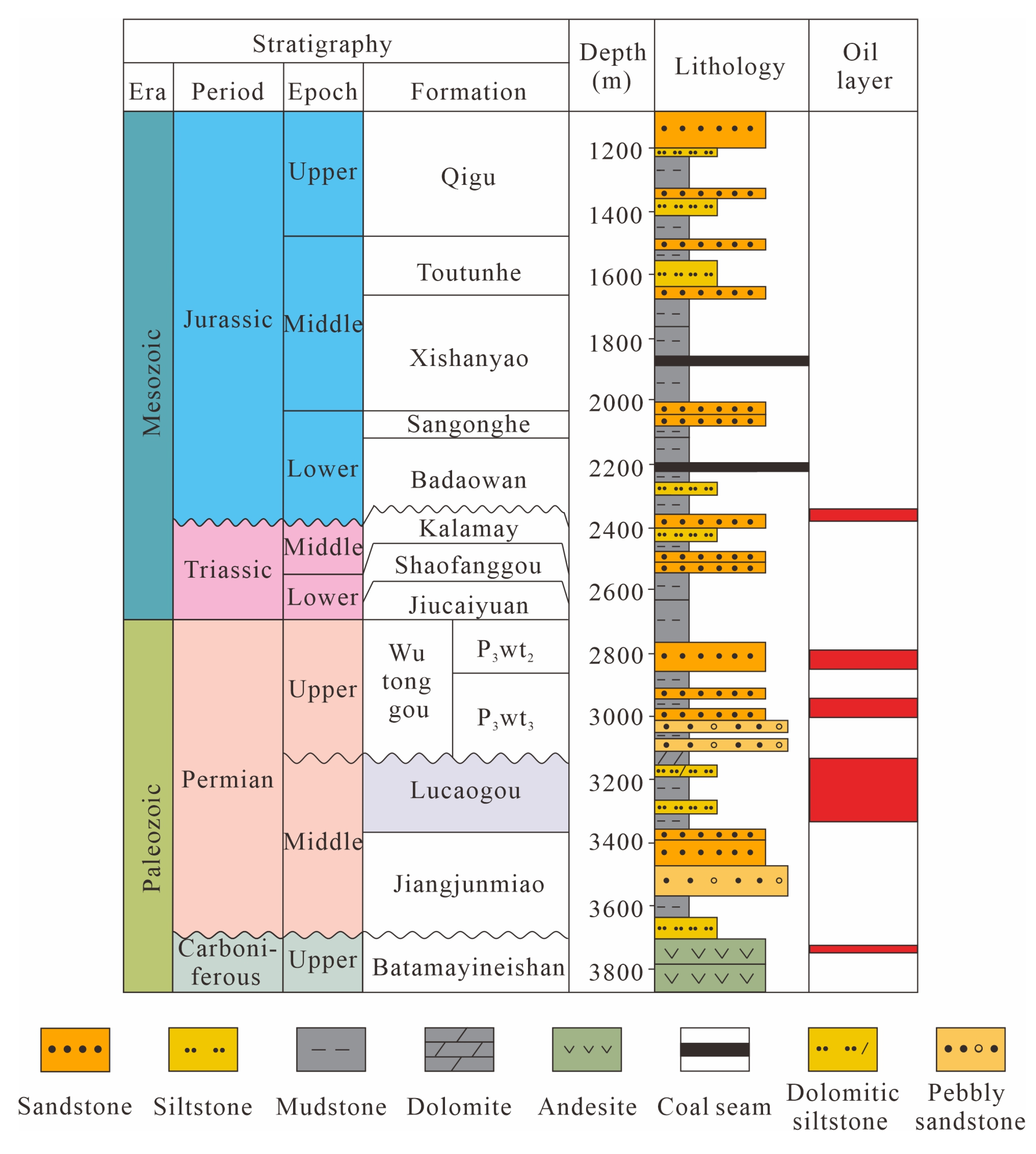



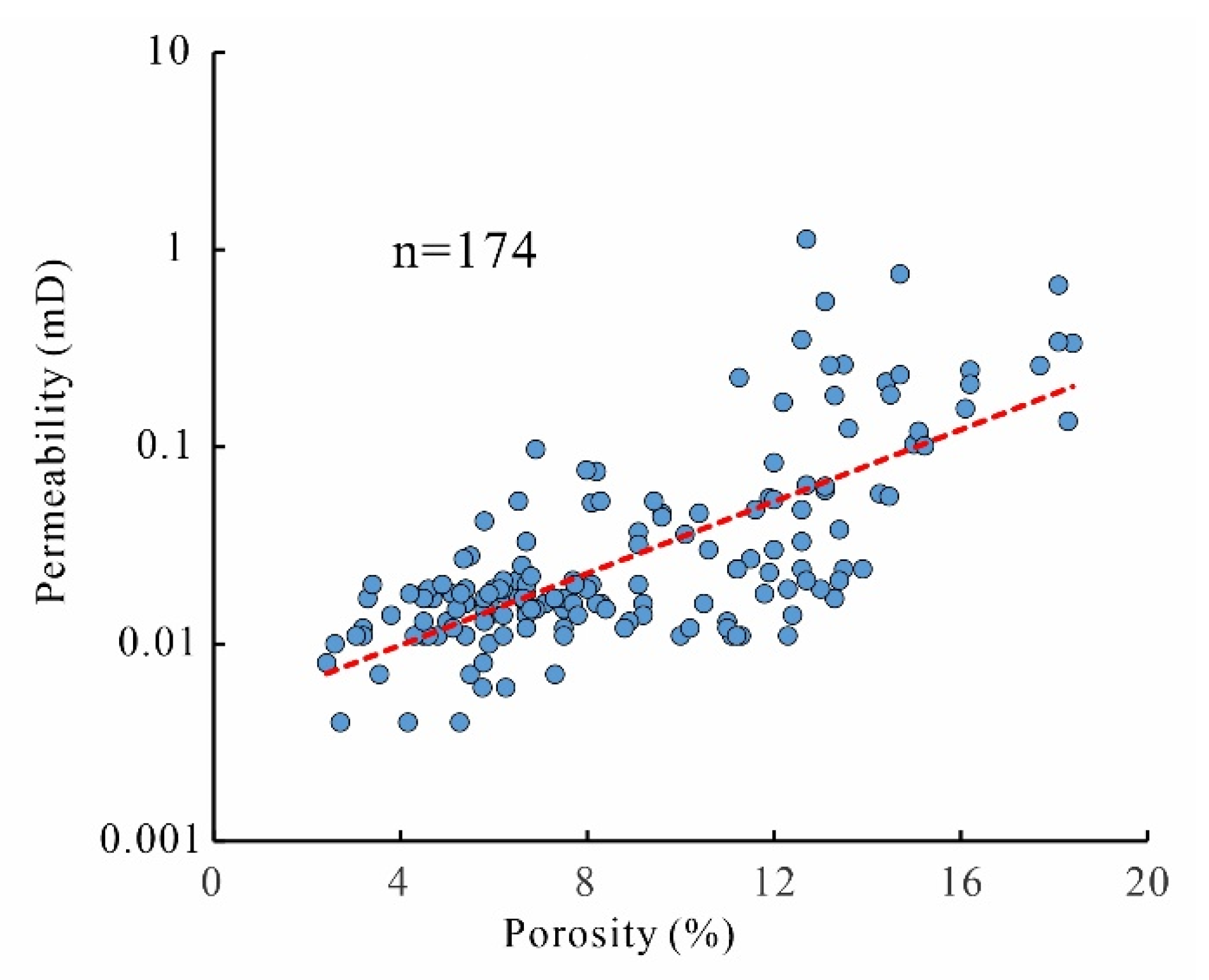


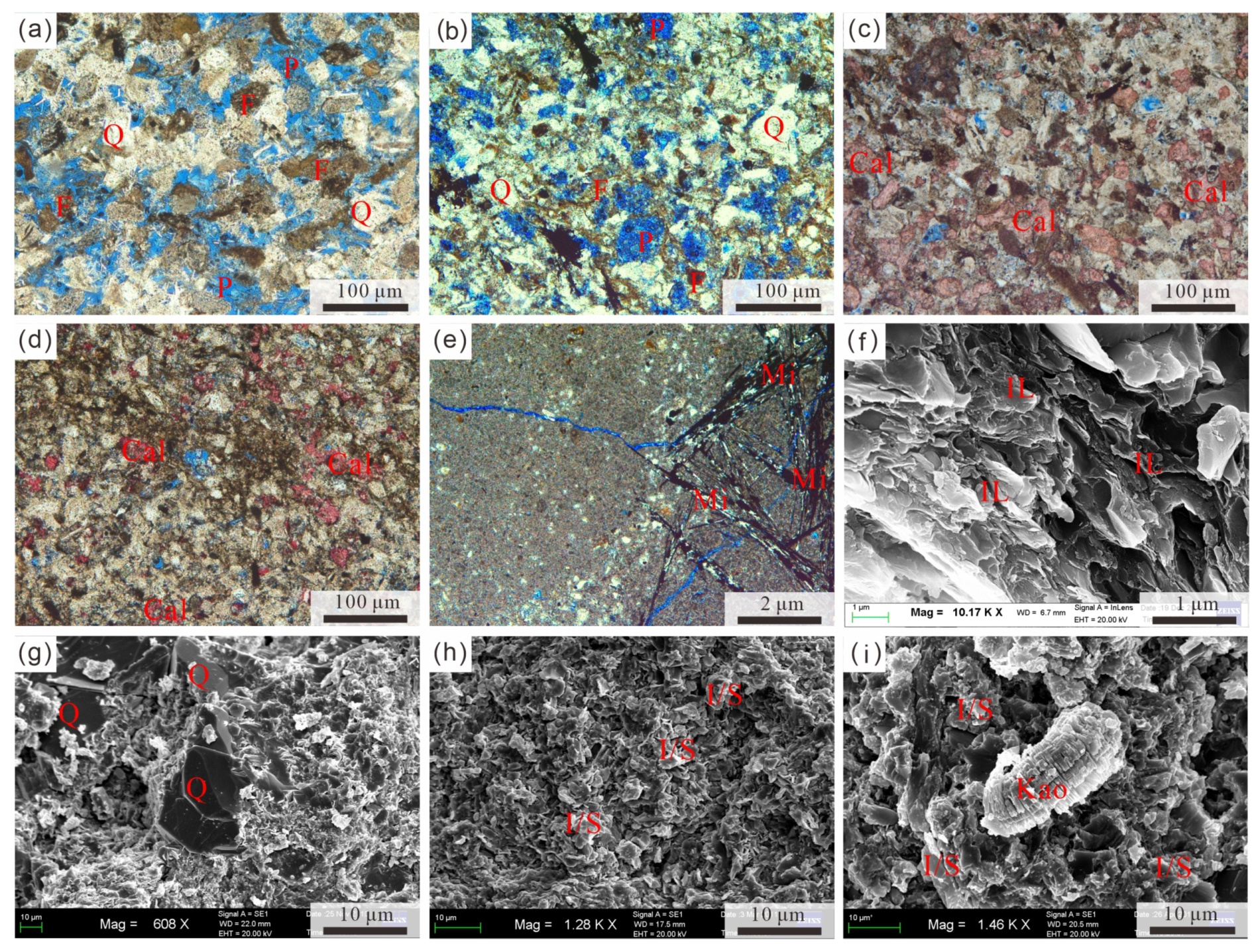
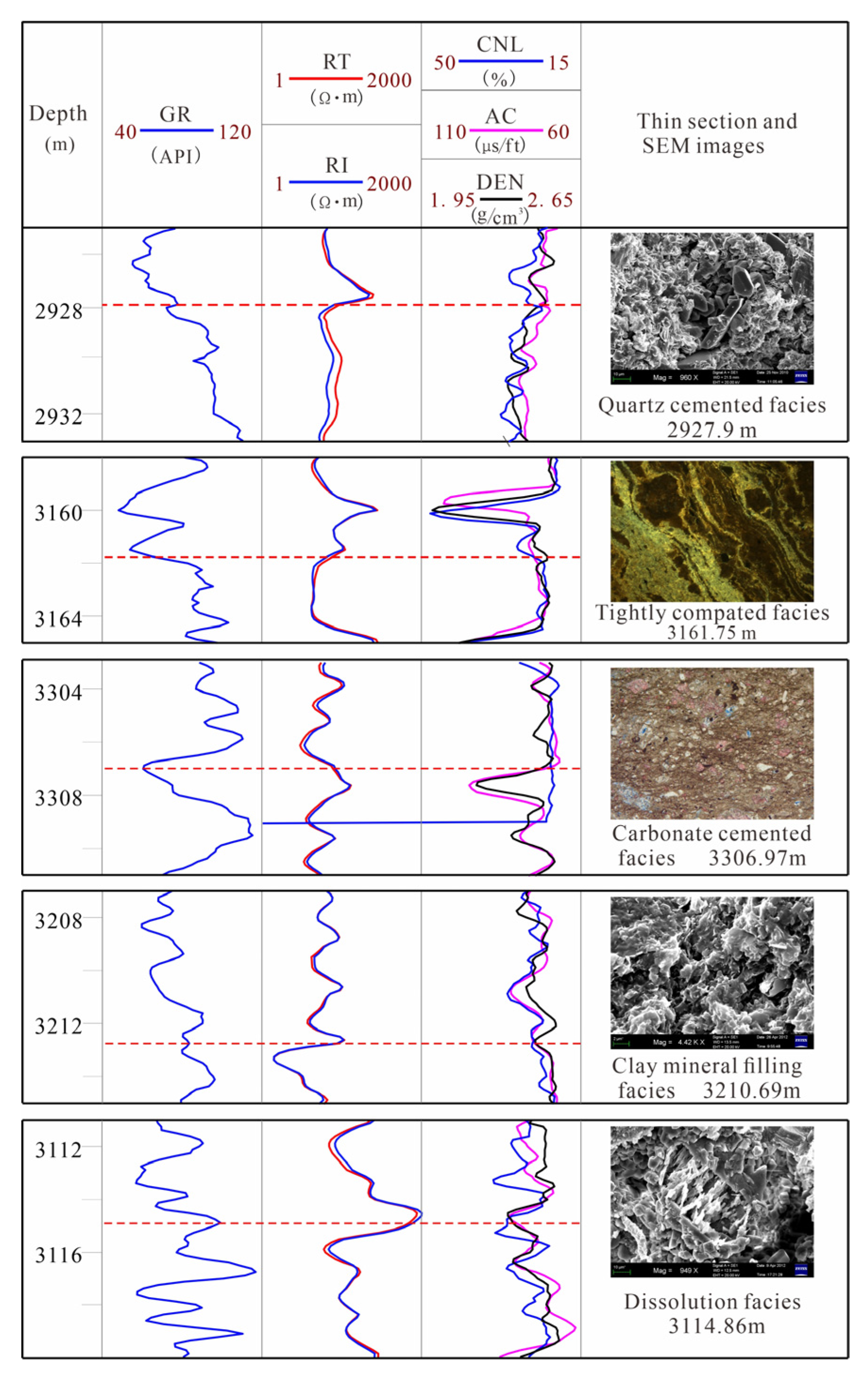
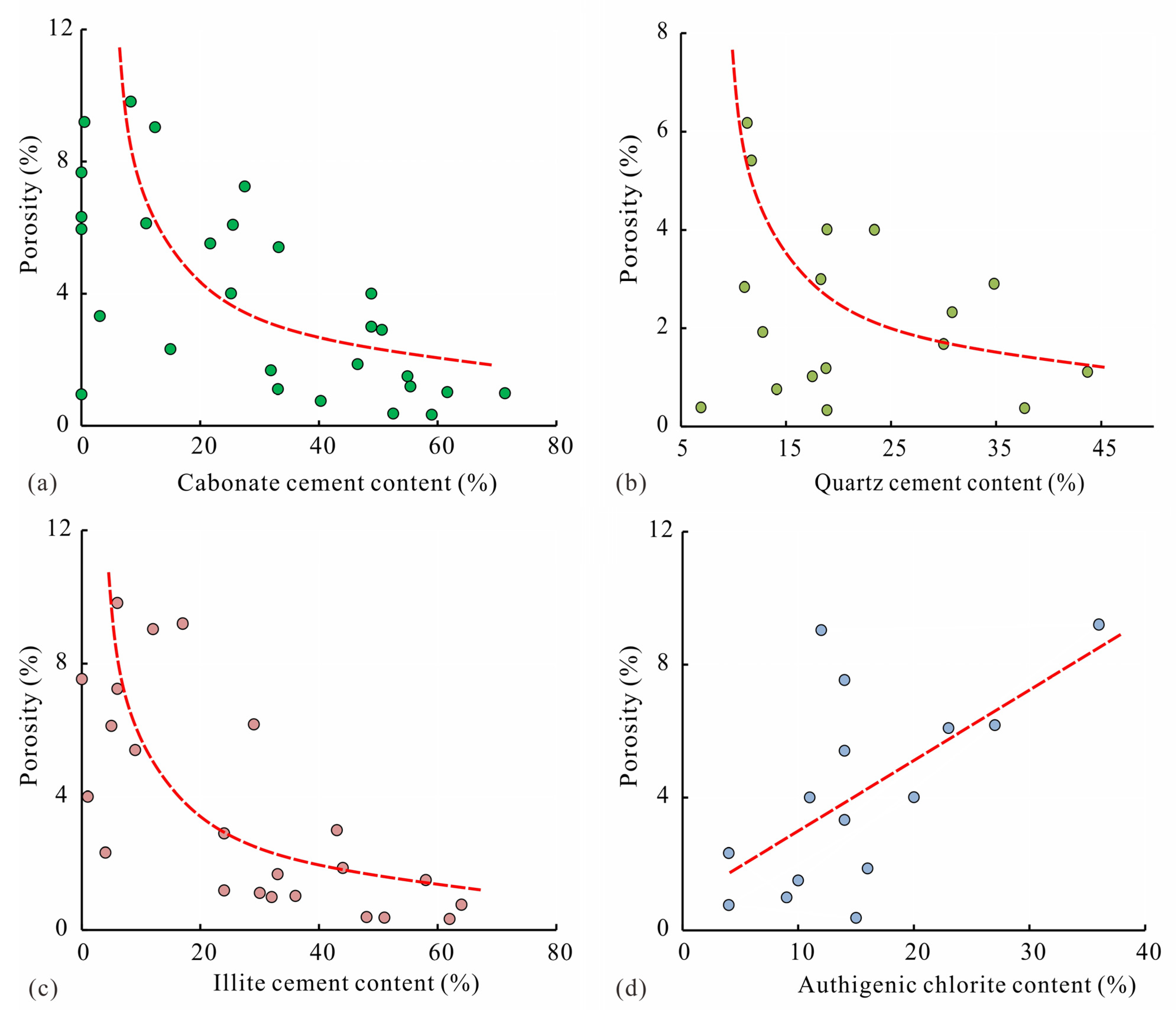

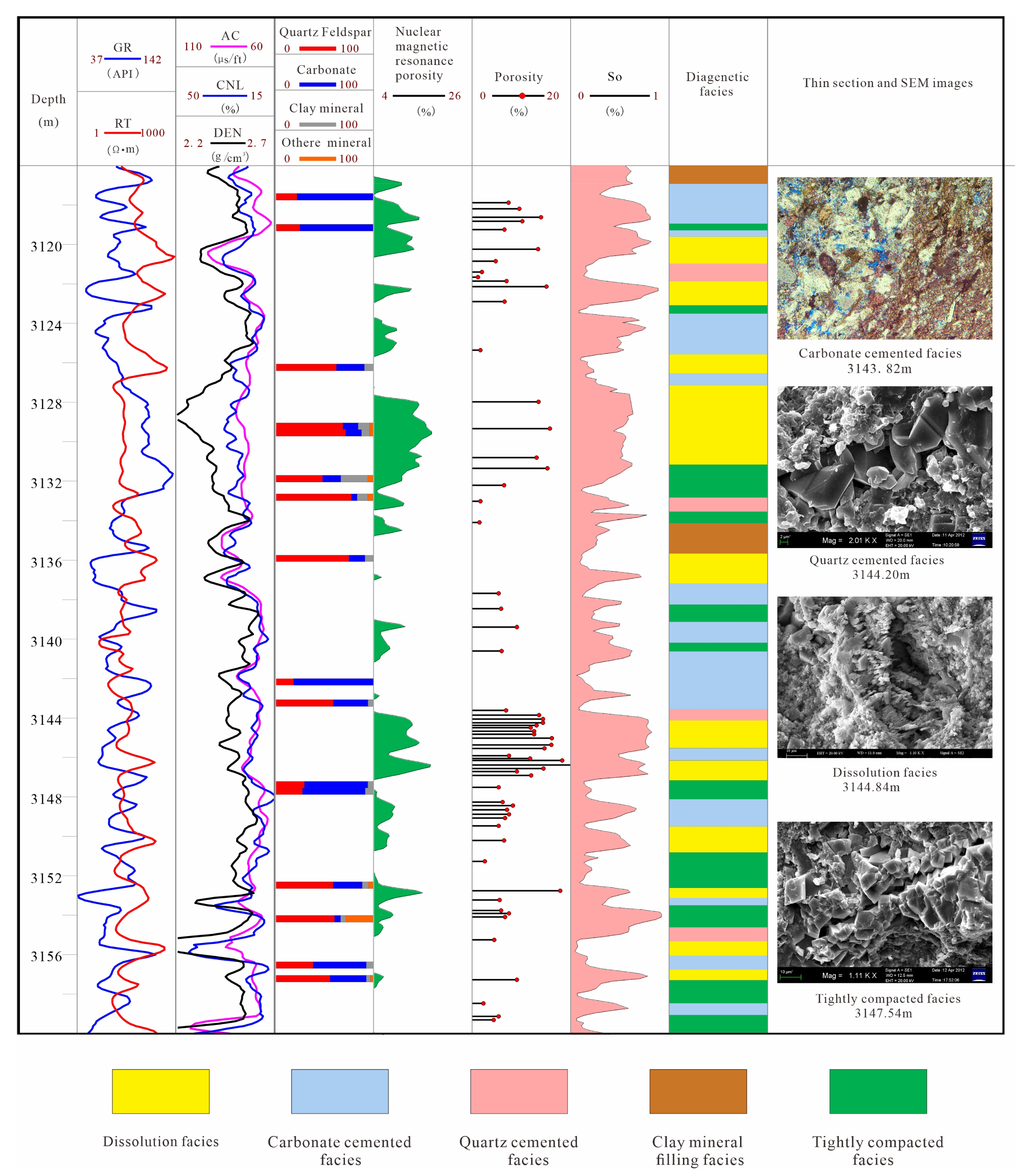
| Name Depth/m | Mineral Composition (%) | ||||||||
|---|---|---|---|---|---|---|---|---|---|
| Clay | Dolomite | Calcite | Pyrite | Potassium Feldspar | Quartz | Anorthite | Ankerite | ||
| J174 | 3217.98 | 20.0 | 15.2 | 14.0 | — | 3.0 | 17.7 | 30.1 | — |
| J174 | 3259.65 | 7.5 | 44.5 | 0.3 | — | 4.0 | 22.5 | 21.2 | — |
| J174 | 3283.38 | 12.4 | 17.7 | 7.4 | — | 4.9 | 17.5 | 40.1 | — |
| J174 | 3285.57 | 11.8 | 31.3 | — | 0.5 | 5.8 | 18.3 | 32.3 | — |
| J174 | 3295.85 | 17.0 | 23.5 | 2.2 | 0.6 | 6.5 | 20.6 | 29.6 | — |
| J174 | 3335.41 | 10.8 | 8.0 | 41.1 | 11.0 | 1.3 | 10.1 | 9.8 | — |
| J251 | 3614.10 | 8.7 | 28.9 | 11.4 | 2.4 | 3.7 | 28.1 | 16.8 | — |
| J251 | 3632.13 | 7.7 | 11.7 | 33.0 | 3.4 | 14.4 | 18.8 | 11.0 | — |
| J251 | 3773.12 | 13.2 | 25.4 | 12.2 | — | 1.7 | 25.6 | 21.9 | — |
| J36-5 | 4348.70 | 33.1 | — | 2.2 | 0.8 | — | 61.2 | 2.7 | — |
| J36-5 | 4349.84 | 46.4 | — | 0.5 | 0.5 | — | 49.8 | 2.8 | — |
| J36-5 | 4353.98 | 45.5 | — | 1.6 | 0.9 | — | 46.9 | 4.2 | 0.9 |
| J36-4 | 4340.35 | 4.9 | — | 1.8 | 0.2 | — | 30.0 | 33.0 | 30.1 |
| J36-4 | 4344.70 | 5.5 | — | 0.4 | 0.4 | 6.0 | 26.3 | 30.4 | 31.0 |
| J36-4 | 4345.36 | 0.9 | — | 81.1 | 0.6 | — | 6.9 | 8.9 | 1.5 |
| J36-4 | 4346.47 | 28.5 | — | 34.9 | — | 1.5 | 14.4 | 11.3 | 9.5 |
| J36-4 | 4347.74 | 5.5 | — | — | 0.2 | 6.7 | 26.0 | 36.1 | 25.5 |
| J36-4 | 4353.11 | 5.1 | — | 29.0 | — | 2.4 | 20.0 | 17.6 | 25.9 |
| J36-4 | 4356.47 | 6.6 | — | 10.3 | 0.3 | 8.3 | 36.0 | 38.5 | — |
| J36-4 | 4358.24 | 1.3 | — | 44.2 | — | 0.9 | 37.7 | 7.6 | 8.3 |
| J36-4 | 4359.12 | 5.1 | — | 17.3 | 0.3 | — | 14.1 | 40.2 | 23.0 |
| J36-4 | 4362.32 | 7.6 | — | 7.3 | 13.8 | — | 28.0 | 33.4 | 10.0 |
| J36-4 | 4363.71 | 3.1 | — | 13.6 | 0.2 | 4.0 | 11.7 | 47.8 | 19.6 |
| J36-4 | 4368.11 | 6.2 | — | 37.1 | 0.5 | 1.7 | 37.5 | 15.7 | 1.4 |
| J36-4 | 4369.50 | 8.1 | — | 32.8 | 0.3 | — | 25.5 | 28.0 | 5.3 |
| J36-4 | 4374.79 | 9.0 | — | 9.3 | 4.9 | — | 21.3 | 44.0 | 11.5 |
| J36-4 | 4380.46 | 5.8 | — | 33.6 | 0.6 | — | 26.1 | 21.3 | 12.7 |
| Average | 12.5 | 22.9 | 19.1 | 2.1 | 4.5 | 24.7 | 23.5 | 14.4 | |
| Diagenetic Facies | GR/API | AC/μs·ft−1 | DEN/g·cm−3 | RT/Ω·m | CNL/% |
|---|---|---|---|---|---|
| Tightly compacted facies | 67.5~138.8 (101.2) | 66.7~78.4 (72.4) | 2.3~2.6 (2.5) | 6.1~40.3 (14.8) | 18.6~30.3 (23.7) |
| Carbonate-cemented facies | 58.5~97.5 (75.7) | 72.5~94.6 (78.6) | 2.0~2.5 (2.4) | 10.9~74.0 (36.3) | 18.5~35 (22.9) |
| Quartz-cemented facies | 61.6~112.5 (88.3) | 67.4~87.5 (74.6) | 2.17~2.5 (2.4) | 14.4~83.8 (31.5) | 18.9~36.4 (25.2) |
| Clay mineral-filling facies | 73.8~111.9 (89.7) | 76.6~94.6 (84.6) | 2.2~2.5 (2.36) | 10.7~73.9 (41.2) | 26~41.9 (32) |
| Dissolution facies | 38.0~87.9 (65.6) | 70.1~93.8 (80) | 2.1~2.6 (2.3) | 112.7~273.1 (177.9) | 22.7~40.8 (30.4) |
Publisher’s Note: MDPI stays neutral with regard to jurisdictional claims in published maps and institutional affiliations. |
© 2022 by the authors. Licensee MDPI, Basel, Switzerland. This article is an open access article distributed under the terms and conditions of the Creative Commons Attribution (CC BY) license (https://creativecommons.org/licenses/by/4.0/).
Share and Cite
Qi, M.; Han, C.; Ma, C.; Liu, G.; He, X.; Li, G.; Yang, Y.; Sun, R.; Cheng, X. Identification of Diagenetic Facies Logging of Tight Oil Reservoirs Based on Deep Learning—A Case Study in the Permian Lucaogou Formation of the Jimsar Sag, Junggar Basin. Minerals 2022, 12, 913. https://doi.org/10.3390/min12070913
Qi M, Han C, Ma C, Liu G, He X, Li G, Yang Y, Sun R, Cheng X. Identification of Diagenetic Facies Logging of Tight Oil Reservoirs Based on Deep Learning—A Case Study in the Permian Lucaogou Formation of the Jimsar Sag, Junggar Basin. Minerals. 2022; 12(7):913. https://doi.org/10.3390/min12070913
Chicago/Turabian StyleQi, Ming, Changcheng Han, Cunfei Ma, Geng Liu, Xudong He, Guan Li, Yi Yang, Ruyuan Sun, and Xuhui Cheng. 2022. "Identification of Diagenetic Facies Logging of Tight Oil Reservoirs Based on Deep Learning—A Case Study in the Permian Lucaogou Formation of the Jimsar Sag, Junggar Basin" Minerals 12, no. 7: 913. https://doi.org/10.3390/min12070913





